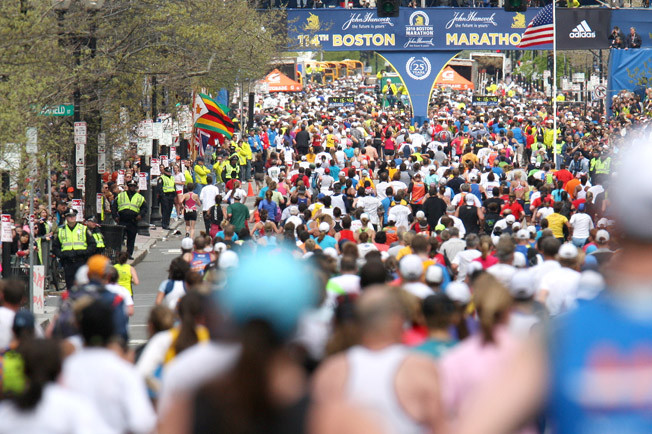How Boston Marathon runners can avoid hitting the wall

A Harvard/MIT student has created an online calculator for prerace carbo loading.
Come tomorrow morning, about 27,000 runners will begin the annual 26-mile, 385-yard (42.195 kilometers) mass run from suburban Hopkinton to Boston.
But if past marathons in Boston and elsewhere are any indication, perhaps up to 40% of these optimistic and determined souls will slam into a sudden sensation of overwhelming, can’t-do-this fatigue several miles (typically about five) before they get a chance to experience the glory of crossing the finish line.
It’s called “hitting the wall.”
Getting through, around, or over hitting the wall is part of the mystique of marathon running, although there’s a physiological explanation that’s not all that mysterious: when runners hit the wall, their bodies have run out of the carbohydrates needed to sustain intense physical activities like long-distance running.
Benjamin I. Rapoport believes many runners could avoid hitting the wall if they put a few key facts about themselves and their target marathon time into the online calculator he created, which can be found at www.endurancecalculator.com. The calculator will tell them how many extra calories they should get from pasta, rice, or other high-carbohydrate food or drink before (and in some cases, during) running a marathon.
More precision
No, Rapoport doesn’t have a concession on pre-marathon carbohydrates; he’s a 29-year-old student in the M.D.-Ph.D. program jointly run by Harvard Medical School and the Massachusetts Institute of Technology.
And the anti–Atkins Diet advice to go ahead and gorge on carbohydrates before endurance events is old news; “carbo loading” with heaps of pasta before marathons is a time-honored tradition.
But after Rapoport experienced hitting the wall firsthand several years ago while running the New York City Marathon, he set out to put some precision into the general advice to carbo load. The result: a dense, equation-filled 12-page paper on metabolic factors limiting marathon performance in the October 2010 issue of PLoS Computational Biology. The online calculator is a condensed, user-friendly version of the important conclusions he drew about the mathematical relationships between running pace, aerobic capacity, and carbohydrate use and storages.
To Rapoport’s pleasant surprise, his paper and the calculator have attracted worldwide media attention. (My favorite headline: “Marathoning made easy.” If Rapoport’s calculator figures out carbo loading and does that, he really is on to something big!)
The attention prompted him to start a consulting business, and he has advised the U.S. national cycling team, as well as some private individuals.
All of this is sideline: Rapoport is planning on a career in neurosurgery and his just-completed Ph.D. thesis is on electronic implants in the brain.
Playing with the calculator
So let’s run some numbers through Rapoport’s calculator.
Robert Kiprono Cheruiyot set a course record when he won the Boston Marathon last year in time of 2 hours, 5 minutes, and 52 seconds (which works out to 4:46 miles, a simply astounding pace).
Cheruiyot’s age (22) was easy to find, but I had to guess about his weight (135 pounds) and his resting heart rate (40 beats per minute), which in Rapoport’s calculator is a proxy for the standard measurement of aerobic capacity, VO2max.
According to Rapoport’s calculator, if Cheruiyot wants to match his 2010 time tomorrow, he should have stoked himself with 1,944 calories of carbohydrates, which is about the number of calories in seven, 1-cup servings of pasta.
Rapoport notes that runners need to count just the calories from the carbohydrates, not the calories from the sauce that typically comes with it, and that the carbo-loading carbs are on top of normal calorie intake. In addition, carbo loading should be completed 12 hours before race time to allow time for digestion and storage.
A more typical runner
Now let’s consider the more typical runner in tomorrow’s marathon: a 45-year-old, 120-pound woman with a resting heart of 60 and a goal of finishing the marathon in 4 hours (9:09 miles). Rapoport’s calculator says her prerace carbo load should be 1,347 calories (five servings of pasta).
But say her resting heart rate was 70 instead of 60. She’d need to increase that to 1,715 calories of carbohydrates, according to the calculator. Why? Because a higher resting heart beat means a lower aerobic capacity, and a lower aerobic capacity means a runner is less fuel efficient: he or she will burn more carbohydrates running at the same pace as a runner with a higher aerobic capacity.
Rapoport’s calculator also figures out how much slower a person would need to run if he or she were to skip carbo loading (and yet still wanted to avoid hitting the wall). Without carbo loading, Cheruiyot would need to drop his pace to 6-minute miles (or slower) and a 2:37:37 finish (or slower). The hypothetical 45-year-old woman runner would need to throttle down to 9:50-mile pace and finish at 4:18:04 or slower.
A rice-fueled Rapaport
I hope to catch a little bit of the marathon tomorrow in Boston at about a mile before the finish. I’ll be keeping an eye out for number 1223, the number Rapoport is wearing.
I plugged his numbers into his calculator (age 29, 145 pounds, an impressive resting of heart rate of 40, a target time of 2 hours and 50 minutes). His carbo loading requirement: 1,349 calories.
When I spoke to him earlier today, he was working on finishing up multiple bowls of white rice, plus some fruit juice, before getting to bed at 6.
(Photo courtesy of Photorun.net, 2010)
About the Author

Peter Wehrwein, Contributor, Harvard Health
Disclaimer:
As a service to our readers, Harvard Health Publishing provides access to our library of archived content. Please note the date of last review or update on all articles.
No content on this site, regardless of date, should ever be used as a substitute for direct medical advice from your doctor or other qualified clinician.












